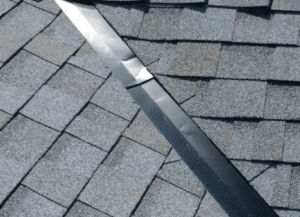Table of ContentsRoof Flashing DetailsEdge Flashing For Your RoofUnderstanding The Fundamentals Of Metal Roof Flashing
Installing headwall and sidewall flashing correctly ends up being more time taking in when the exterior wall covering is brick or stone."Lengthy" can suggest "more pricey", which is why a lot of the counter flashing you'll see at brick and stone walls will be incorrectly set up and will entirely count on some sort of sealant to prevent moisture invasion.
 Ultimate Guide To Roof Flashing
Ultimate Guide To Roof Flashing
This is why it is suggested to set up remorse flashing to guarantee the most protection from moisture intrusion. Step Flashing Action flashing is an L-shaped piece of metal, generally aluminum or galvanized steel, and is used where a sloped roofing intersects a vertical wall. Step flashing is linked with the shingles and act basically as shingles with an unturned leg to allow a transition of the vertical drain airplane of the wall to the drain aircraft of the roofing.
 A Roofing Expert Explains Roof Flashing
A Roofing Expert Explains Roof Flashing
The bottom leg of the step flashing is placed over the roofing system drainage plane. A vital part of the action flashing is the piece that is at completion of the slope of the roofing system is called the kickout flashing. This roof flashing directs water away from the adjoining wall and guarantees that the step flashing is not gathering water on the surface area of that wall.
Is Roof Flashing Important?
Step flashing reroutes the water back onto the shingle and away from valleys and joints. Even if one piece of action flashing fails, the next flashing and shingle below it start the process over once again, offering a system to safeguard your roof from water damage. Continuous flashing against a sidewall is one method to set up flashing on a roof, however it's not the right way.
When even a small section of the continuous flashing stops working, you'll have a leak. Each additional rainstorm will add more water, and before you understand it, you have actually got rotted wood and a roof inspector in your house. Step flashing deals far better protection from leakages due to the fact that even if a single piece of action flashing fails, the water just hits the next step of the flashing.
Kickout flashing which can also be called diverter flashing is a special kind of flashing installed at the edge of the flashing that diverts rainwater away from the cladding and into the rain gutter. When your roofing specialist installs kickout roofing Tucson AZ - DCRoofingArizona.com flashing appropriately, the flashing will offer excellent defense against the penetration of water behind the outside wall covering where the flashing ends.
Understanding Roof Flashing
Kickout Flashing Yes, there can be a number of elements that can lead to rainwater invasion, however a missing out on kickout flashing, in specific, typically leads to focused locations of water accumulation and potentially extreme damage to exterior walls. If you take place to discover saturation and possibly plant development on the outside siding of your home, you might have missing kickout flashing triggering the water damage.
https://www.google.com/maps/embed/v1/directions?key=AIzaSyAT8ig6vIZpArpz5aokN-7eevoH-Unfy0Y&origin=32.1433135,-110.9163409&destination=2202 S Calle Yucatan&mode=driving
Having this flashing properly installed is important in protecting some of the most vulnerable areas of your roof. Apron Flashing Apron flashing is usually used as part of the two-piece roof system. The apron is the lower L shaped piece that changes the typical step flashing, which covers the roofing material and extends up the vertical surface area of the roofing system penetration.
DC Roofing of Arizona
Tucson, AZ
(520) 979-9095
https://www.dcroofingarizona.com/
https://www.google.com/maps?cid=13615084232433183222
Now that you have had a breakdown of the crucial function that roofing system flashing plays when it pertains to the protection of your https://sergiokwjz127.edublogs.org/2020/11/24/roof-flashing-weatherproofing-material-to-protect-roof-joints/ roofing system, it is simple to see why it is needed on practically all roofing tasks. Without roofing flashing, our roofs would be far more prone to water damage, costing property owners countless dollars in repair work or replacement.